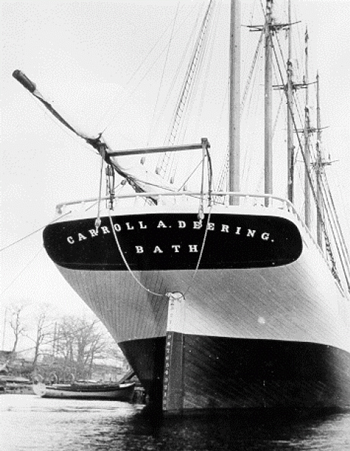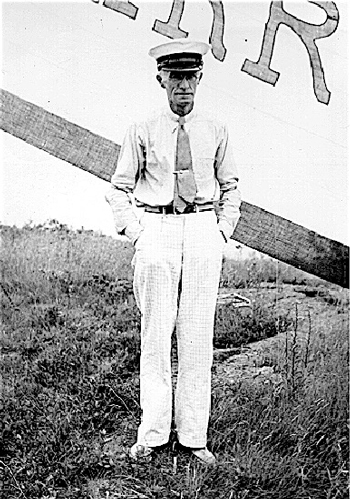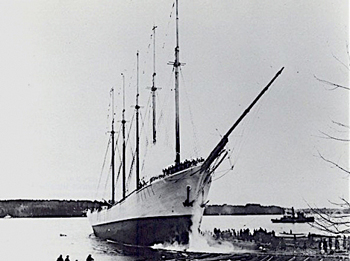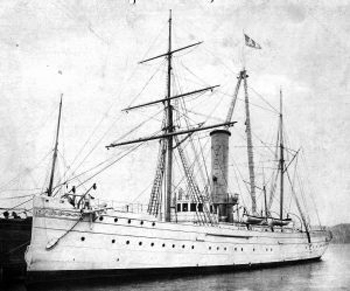The Curious Case of
The Carroll A. Deering
by Tom Seymour

Captain Wormell complained about his crew, none of which he trusted.
One of the greatest maritime mysteries ever concerns the five-masted, Maine-built schooner, Carroll A. Deering. Found grounded and crewless on Diamond Shoals, North Carolina, a place known as, “the graveyard of the Atlantic,” the facts behind the circumstances surrounding the Deering and crew remain unclear.
The Carroll A. Deering was one of the few remaining vestiges of the age of sail to continue working and, to her credit, to earn a profit. To cite more superlatives, the Deering was the last and largest, wooden cargo vessel completed by G.G. Deering Company of Bath, Maine.
Launched in 1919 and put into service that same year, the vessel was 225 feet long, 45 feet wide, had 5 masts and 3 decks. And while the Deering was a cargo ship, she was outfitted in the style of a passenger vessel, being trimmed in oak, ash and mahogany, with a working lavatory, electricity and even steam heat.
Carroll A. Deering sailed without incident for nearly 18 months when, loaded with coal, she departed Norfolk, Virginia, on 22 August, 1920, bound for Rio de Janeiro, Brazil. Her captain was William H. Merritt, renowned World War I hero. Captain Merritt recruited his son, Sewall Merritt, to serve as first mate. The 10-man crew, according to Wikipedia, was comprised of Scandinavians, mostly Danes.
Only a few days had passed before Captain Merritt fell seriously ill and could no longer continue as captain. Therefore, the ship reversed course in order to land the ailing captain at the port of Lewes, Delaware. Sewall, the captain’s son, also disembarked in order to care for his father. Little did either man know that this supposedly unfortunate incident was a blessing in disguise.
Informed of the situation, the Deering Company called from retirement and contracted with Captain Willis B. Wormell, an experienced sea captain, to serve as captain. Charles B. McLellan was signed on as first mate. After this, the Deering resumed her journey on September 8, 1920 and arrived in Brazil without further incident, where she delivered her cargo of coal.

Captain Willis B. Wormell, an experienced sea captain, replaced Captain William Merritt who had fallen seriously ill.
While in Rio, Captain Wormell gave his crew shore leave while he, himself, again according to Wikipedia, met with an old acquaintance, one Captain Goodwin, a Mainer and captain of another bath-built, five-masted vessel, which was docked alongside the Deering. Captain Wormell complained to his friend, Captain Goodwin, about his crew, none of which he trusted, with the single exception of the engineer, Herbert Bates, another Maine man, in charge of the ship’s steam-powered hoisting engine.
Both men were aware of the difficulties in assembling a crew to serve on a sailing vessel, since most seamen preferred the better working conditions and according to Ingrid Grenon in her book, Lost Maine Coastal Schooners, somewhat better pay offered on steam-powered vessels. But there was nothing either captain could do about that and in the end, the only available option was to try to make do with their existing crews.
Brewing Discontent
With her cargo of coal unloaded, the Carroll A. Deering, then headed for Barbados, where the Scottish first mate, McLellan, became drunk and belligerent. He then spoke with Captain Hugh Norton, of the Snow, complaining that Captain Wormell always interfered with him each time he attempted to discipline the crew. McLellan also groused that because of Captain Wormell’s failing eyesight, he, McLellan, was compelled to do the navigating in the captain’s place.
Some time later, Captain Norton, along with his first mate and another sea captain, were in the Continental Café, where they overheard McLellan boast that he would “get” his captain before the Deering reached Norfolk. McLellan was so drunk that authorities arrested him, but kind and forgiving Captain Wormell bailed him out and brought him back to the ship. This was on January 9, after which the vessel headed out for Hampton Roads.
Fatal Course

The launching of the Carroll A. Derring at the G.G. Deering Co. yard in Bath, Maine 1919. Among the last of the great schooners it was beautifully built and appointed.
Twelve days later, on January 28, 1921, a tall, thin man with reddish hair (those on the lightship thought the man may have been Scandinavian), aboard the Deering, hailed the Cape Lookout Lightship Vessel 80, saying through a megaphone, that the vessel had lost its anchors in a fierce storm and asked that someone notify G.G. Deering Company, the ship’s owners, of the situation.
Captain Jacobson, keeper of the lightship, noted that he was unable to report the Deering’s lost anchors because his radio had gone out. Captain Jacobson also became suspicious when he watched the Deering’s crew, “milling around,” on the quarterdeck, a place where crew members typically did not venture.
The Carroll A. Deering presented such a fine sight that the lightship’s engineer took a photo of her as she sailed past. Five-masted schooners, indeed any wind-powered, commercial craft, were nearing the end of their days and the Deering was a fine example of the best that old-time shipbuilders had to offer.
The next day, someone in the crew of another vessel, became alarmed when they saw the Deering sailing on a route that would ultimately lead her into the infamous, Diamond Shoals. Diamond Shoals extends for miles out from Cape Hatteras, beckoning, siren-like, vessels to venture too near. Over the years, numerous vessels found their untimely end on these shoals and the tally of wrecks gave Diamond Shoals the distinction of being considered the most dangerous section of the Atlantic seaboard.
The other vessel’s crew saw that the Deering’s decks were empty and did not try hailing the big schooner. Also, they thought for sure that the Deering’s crew would notice the Cape Hatteras Lighthouse and take measures to change course and thus avoid a calamity of gross proportions.
The Wreck

The USCG cutter Seminole. Powered by both sail and engine. It attempted to get close enough to pull the Deering off the rocks. Shallow water and stormy seas made it impossible.
At daybreak of January 31, 1921, surfman C.P. Brady, while on lookout duty at Cape Hatteras Coast Guard Station, spied Carroll A. Deering, with all sails set, hard aground. A storm, coupled with high winds, prevented rescuers from approaching the doomed vessel. For four days these conditions persisted, but finally, on February 4, rescue ships arrived and rescuers boarded the stricken Deering. It was immediately apparent that the vessel was abandoned, with only the three, ship’s cats left to tell the tale.
The Deering’s steering apparatus was damaged and the wheel broken to pieces. Navigation equipment was missing, as was the ship’s log. The crew’s personal belongings were gone, as were the ship’s two lifeboats. More startling, inspection of the ship’s galley revealed that food was in the process of being prepared but the meal was never served.
After this, Coast Guard vessel, Manning, tried, unsuccessfully, to salvage the wrecked vessel, but the Deering could not be moved. And so the vessel was declared a hazard to navigation and on March 4, the once-proud, five-masted schooner was destroyed by dynamite so that it would not become a hazard to other vessels.
Later, a part of the Deering’s bow, along with timbers from the vessel, washed ashore on Hatteras Island, where local people seized the timbers for construction purposes.
Aftermath
And thus Carroll A. Deering became a ghost ship. To add to the puzzle, the Sulphur steamship, Hewitt, bound for Portland, Maine, dropped out of sight the night of the Deering’s grounding. As with the captain and crew of the Deering, no trace of Hewitt was ever found.
Had the Hewitt rescued the Deering’s crew and shortly thereafter, met with disaster herself? No one knows. But this was not the only theory circulating at the time. Speculation ran rampant and pirates, rumrunners, leftover mines from World War I and even the Russians, were considered potential causes for the disaster.
And so Secretary of Commerce, Herbert Hoover, placed his assistant, Lawrence Ritchey, in charge of the official investigation. Ritchey attempted to patch together the situation aboard the Deering from the time it was sighted by the lightship and the time it went aground on Diamond Shoals. But logbooks of different lightships posted in the vicinity revealed no further clues.
However, another vessel, Monte San Michele, had disappeared at the same time and an Italian court of inquiry noted that powerful hurricanes were active at the time of the vessel’s disappearance. Ritchey interpreted that to indicate that the Deering’s crew had mutinied in the face of the storm and so closed the investigation. But since nothing could be proved either way, the investigation ended without an official finding or statement.
But a good ghost ship story never really ends and on April 11, 1921, a fisherman, Christopher Columbus Gray, turned a bottle with a message inside to the authorities. Gray said he had found the bottle floating just off Buxton Beach, North Carolina.
The message read:
“DEERING CAPTURED BY OIL BURNING BOAT SOMETHING LIKE CHASER. TAKING OFF EVERYTHING HANDCUFFING CREW. CREW HIDING ALL OVER SHIP NO CHANCE TO MAKE ESCAPE. FINDER PLEASE NOTIFY HEADQUARTERS DEERING.”
This appeared to provide some answers to the question of the missing crew. But such hope was short-lived, since federal agents later questioned Gray and got him to admit to foraging the note. Gray had hoped that by placing himself in the limelight, that would improve his prospects of being hired at Cape Hatteras Light Station. This, of course, backfired.
The disappearance of Carroll A. Deering, her captain and crew, remain a mystery to this day. However, modern theorists suggest that since part of the Deering’s voyage took her through the now-infamous, Bermuda Triangle, that supernatural forces were at play in the disappearance and grounding of the vessel.
Today, the ship’s bell and capstan are on display at the Graveyard of the Atlantic Museum in Hatteras.
